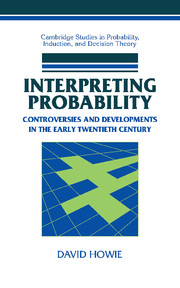Book contents
- Frontmatter
- Contents
- Acknowledgments
- 1 Introduction
- 2 Probability up to the Twentieth Century
- 3 R.A. Fisher and Statistical Probability
- 4 Harold Jeffreys and Inverse Probability
- 5 The Fisher–Jeffreys Exchange, 1932–1934
- 6 Probability During the 1930s
- 7 Epilogue and Conclusions
- Appendix 1 Sources for Chapter 2
- Appendix 2 Bayesian Conditioning as a Model of Scientific Inference
- Appendix 3 Abbreviations Used in the Footnotes
- Bibliography
- Index
- Frontmatter
- Contents
- Acknowledgments
- 1 Introduction
- 2 Probability up to the Twentieth Century
- 3 R.A. Fisher and Statistical Probability
- 4 Harold Jeffreys and Inverse Probability
- 5 The Fisher–Jeffreys Exchange, 1932–1934
- 6 Probability During the 1930s
- 7 Epilogue and Conclusions
- Appendix 1 Sources for Chapter 2
- Appendix 2 Bayesian Conditioning as a Model of Scientific Inference
- Appendix 3 Abbreviations Used in the Footnotes
- Bibliography
- Index
Summary
“It is curious how often the most acute and powerful intellects have gone astray in the calculation of probabilities.”
William Stanley JevonsTHE MEANING OF PROBABILITY
The single term ‘probability’ can be used in several distinct senses. These fall into two main groups. A probability can be a limiting ratio in a sequence of repeatable events. Thus the statement that a coin has a 50% probability of landing heads is usually taken to mean that approximately half of a series of tosses will be heads, the ratio becoming ever more exact as the series is extended. But a probability can also stand for something less tangible: a degree of knowledge or belief. In this case, the probability can apply not just to sequences, but also to single events. The weather forecaster who predicts rain tomorrow with a probability of ½ is not referring to a sequence of future days. He is concerned more to make a reliable forecast for tomorrow than to speculate further ahead; besides, the forecast is based on particular atmospheric conditions that will never be repeated. Instead, the forecaster is expressing his confidence of rain, based on all the available information, as a value on a scale on which 0 and 1 represent absolute certainty of no rain and rain respectively.
The former is called the frequency interpretation of probability, the latter the epistemic or ‘degree of belief’ or Bayesian interpretation, after the Reverend Thomas Bayes, an eighteenth-century writer on probability.
Information
- Type
- Chapter
- Information
- Interpreting ProbabilityControversies and Developments in the Early Twentieth Century, pp. 1 - 13Publisher: Cambridge University PressPrint publication year: 2002
